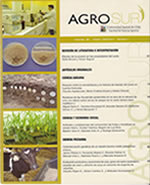Soil organic matter content and soil texture on the biological performance of P. herrmanni Germ. larvae
Main Article Content
Abstract
Glasshouse studies were carried out to determine the influence of soil texture and soil organic matter content (OM) on the weight and survival of the root-feeding scarabaeid larvae Phytholoema herrmanni Germ. (Coleoptera:Scarabaeidae:Melolonthinae). Survival and weight of third instar larvae were examined in three soil textures (silty loam, sandy loam and sand). Soil texture had a significant influence on larval survival, which was higher in soils rich in clay and silt, than in soils with a high presence of sand particles, however, soil texture did not affect larval weight. On the other hand, the increases in OM percentage and OM type (lability) in a volcanic ash derived soil of different horizons increase the larval weight and survival. This OM effect only occurs on larval survival when soils of horizon A of different origins and texture were tested. The differences observed in the response to the OM could be linked to the type of organic matter because horizon A soils present a larger proportion of labile organic matter than horizon B soils and this could be related to the feeding behaviour of Melolonthinae species (root feeders), however, further studies are needed to confirm this finding.

